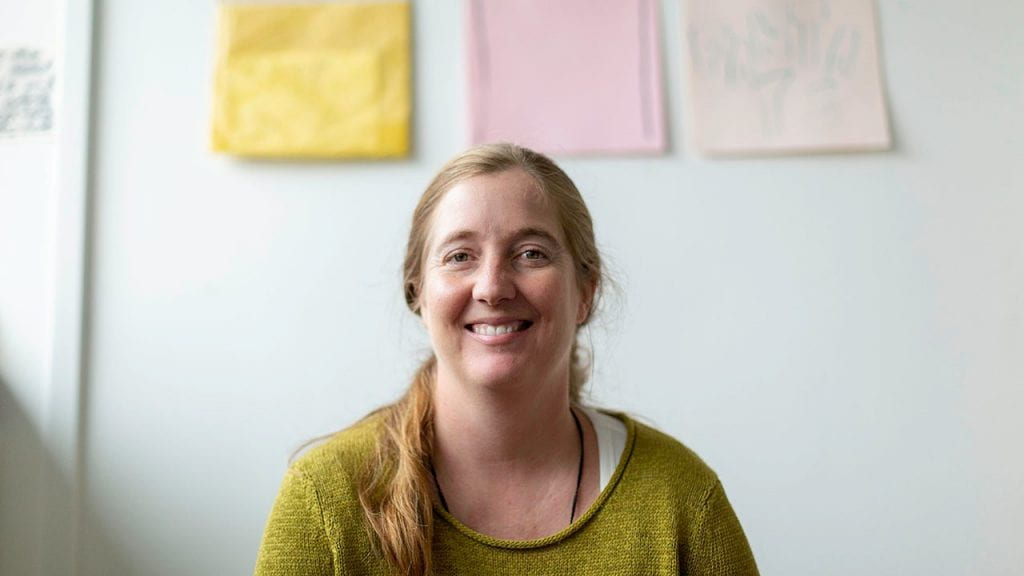Care as a practice and an orientation in teaching dance
“Theorized as an affective connective tissue between an inner self and an outer world, care constitutes a feeling with, rather than a feeling for, others. When mobilized, it offers visceral, material, and emotional heft to acts of preservation that span a breadth of localities: selves, communities, and social worlds.”1 (p.2)
Associate Professor Alys Longley teaches dance in Creative Arts and Industries. She is Course Director for DANCE 101/G: Introduction to Dance and Creative Processes, a 12-week course, designed for first year students. The course aims to develop an understanding the moving body, through movement awareness, dance improvisation, choreography and creative and analytic writing.
In this practice example, Alys describes how she embeds relationality in her teaching practice.

Care as a practice and an orientation
“[Care is] a species activity that includes everything that we do to maintain, continue, and repair our ‘world’ so that we can live in it as well as possible. That world includes our bodies, our selves, and our environment, all of which we seek to interweave in a complex, life-sustaining web.”2 (p. 40)
- Discussing care and wellbeing as a central issue in assessments and expectations
- Emphasising care of self and family in how students were expected to perform academic values
- Attending to the “ways care moves through affect, through often-less-tangible qualities such as the tone of the room, or the way that communities are created.”
(Connections between students and teachers)
Many of the practices shared here are adapted from that article.
Connection to place
At the beginning of her Stage 1 dance course, Alys asks students to introduce themselves through movement. Drawing from the elements of a pepehā, students are asked to choose a landform, a waterway and a group of people that are important to them, to use these elements as the inspiration to create original dance phrases which they share with each other and have the option of developing into assessment submissions. Alys explains and demonstrates this in the video.
(Connections between students and place)
(Connections between students and teachers)
(Connections with peers)
‘Weak theory’ and ‘weak education’
Alys and colleagues apply the concept of ‘weakness’ in their understanding of education and pedagogy. They draw from Eve Kosofsky Sedgwick’s writings on weak theory4 and Gert Biesta’s discussion of weak education.5 These approaches to “weak, rather than strong practice support knowledge and theory as fluid, mobile, and relational. We recognise that a multiplicity of singular approaches rather than a generalised, normative or hierarchical framing of achievement” can enable students to value their difference and diversity, as students can have endless different responses to the same creative task.
Alys and colleagues further elaborate:
“We consider weak approaches to theory and education to allow creative, embodied and relational approaches to teaching to thrive. In teaching interdisciplinary creative education in a large university, weakness is also valuable when considering multi-modal practice, as this approach to learning turns away from mastery to support vulnerability, experimentation, imperfection, and learning-with-others. This requires an explicit move away from the hierarchical language of much normative education to value care and relationship over excellence and replicability.”
Alys believes that university courses can simultaneously support both weak approaches and students who wish to strive for excellence – the key factor is prioritising imperfection, attempt and risk-taking in certain teaching moments and mastery at other moments. Also important is emphasising that students’ self-worth or creative potential is not linked to their grades. Grades are one thing to strive for in learning situations alongside many other important foci such as community, participation, joy, originality, well-being and intrinsic motivation.
Care in the University
Drawing on Tronto’s6 poetics of care, they assert that “as educators, our commitment to wellbeing and our acts of care are of utmost importance in precarious times.” They ask: “How does care fit into the language and values of academia? Who bears responsibility for the interstitial work of holding space and attending to how, rather than what, students are experiencing [in] academic study?”
Alys and colleagues note that care is often undervalued, being associated with the household, private sphere and typically feminised work.2 They note that a practice of care requires “careful preparation, attendance to the diverse needs of students, imagination and empathy.” They call for care to be more strongly valued across all kinds of institutions, including the contemporary university.
- Hobart, Hi‘ilei Julia Kawehipuaakahaopulani and Tamara Kneese. “Radical Care: Survival Strategies for Uncertain Times.” Social Text 38, no. 1 (2020): 1-16. https://doi.org/10.1215/01642472-7971067. ↩
- Tronto, Joan & Berenice Fisher. “Toward a Feminist Theory of Caring.” In Circles of care: Work and Identity in Women’s Lives, edited by Emily K. Abel & Margaret K. Nelson, 36-54. Albany, NY: SUNY Press, 1990. ↩
- Longley, Alys, Janaína Moraes, and Joanna Cook. “Reaching Across from Here to There, in Precarious Times.” Critical Studies in Teaching and Learning (CriSTaL) 10, no. SI (2022): 81-108. https://doi.org/10.14426/cristal.v10iSI.523. ↩
- Sedgwick, Eve Kosofsky. Touching Feeling: Affect, Pedagogy, Performativity. Durham: Duke University Press, 2003. ↩
- Biesta, Gert. “On the Weakness of Education.” Philosophy of Education Yearbook (2009): 354-362. http://hdl.handle.net/10993/7817. ↩
- Tronto, Joan. “An ethic of care.” Generations 22, no. 3 (1998), 15-20. https://www.jstor.org/stable/44875693 ↩
